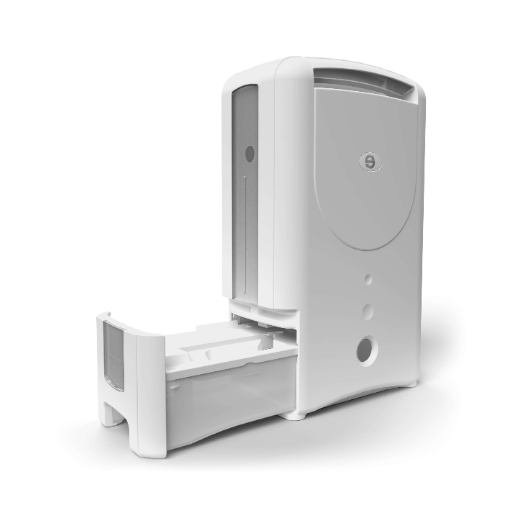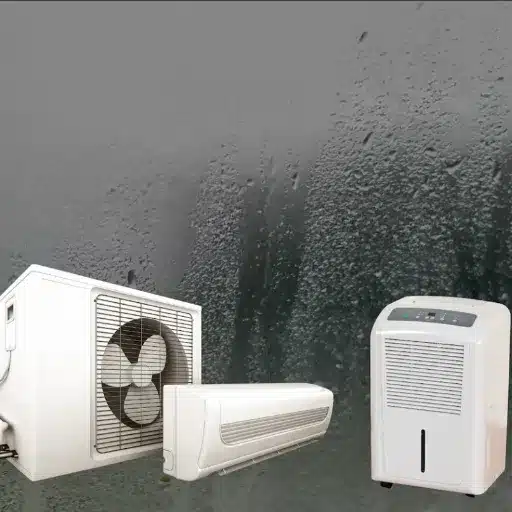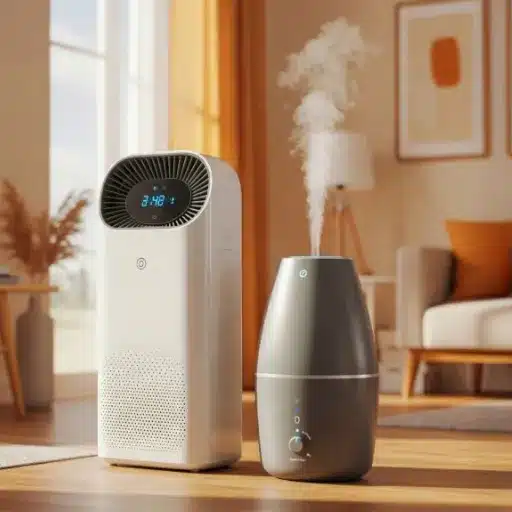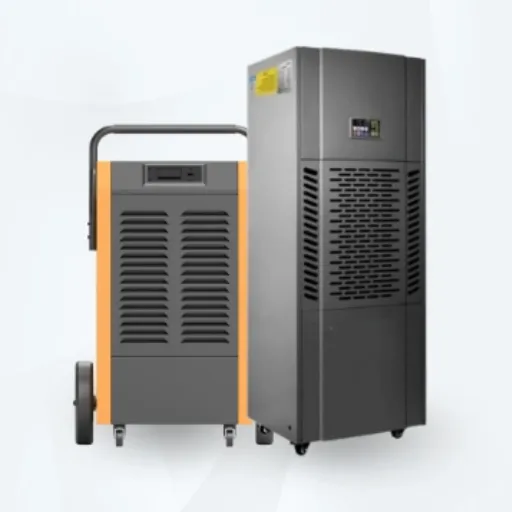When it comes to maintaining indoor air quality and preventing excess humidity from wreaking havoc on homes and commercial spaces, dehumidifiers play a pivotal role. Among the various types available, rotary dehumidifiers have emerged as a highly efficient and versatile option. But how do they work, and what specific advantages do they offer compared to other widely-used models, such as desiccant dehumidifiers? This article aims to break down the intricate functionality of rotary dehumidifiers, highlight their key benefits, and provide a thorough comparison with desiccant models. Whether you’re looking to optimize your indoor environment or simply understand the technology behind humidity control, this comprehensive guide will equip you with the knowledge to make an informed decision.
Rotary Dehumidifiers: Overview, Functionality, and Main Components
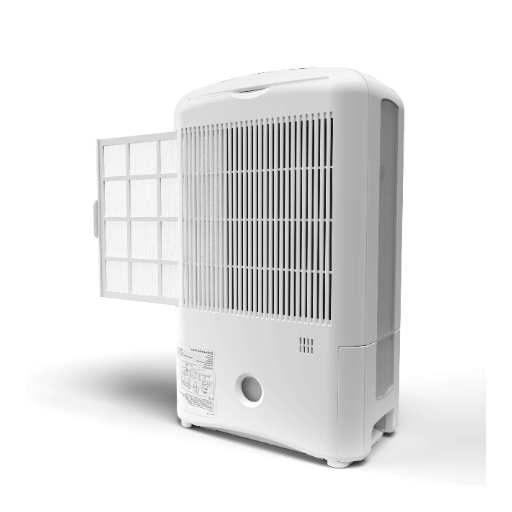
What is a Rotary Dehumidifier?
Rotary dehumidifiers represent a class of dehumidification systems that use the ever-rotating desiccant wheel as the operational medium to extract moisture from the air. With the desiccant wheel generally made out of moisture-absorbent materials such as silica gel, the unit rotates between two different air streams. One stream takes in moisture from the air, whereas the other dries or regenerates the desiccant with the application of heat, which liberates the moisture. Hence, the continuous process keeps humidity control efficient and constant.
In environments where temperatures are low or in settings where precision must be paid to manipulating the humidity, such as industrial or manufacturing areas, these dehumidifiers are useful. Unlike refrigerators, rotary dehumidifiers work differently; systems that depend on the condensation of water vapor may not work efficiently in cold weather, thus making the said dehumidifier the preferred choice. They may also consume less energy than conventional systems when drying large volumes of air, with the provision of particular drying conditions, rendering these systems in some scenarios very efficient.
Besides their reliability, the rotary dehumidifier gives an efficient drainage solution as it needs little to no maintenance. Rotary dehumidifiers can work for extended periods without any significant degradation in performance, allowing for a very large industrial setup requiring continuous dehumidification. On the other hand, the sustained humidity level control prevents any potential cyanogenesis, material deterioration, etc., which is very pertinent to pharmaceutical, food-processing, and other industrial applications allied to electronics. This sturdy technology provides a flexible solution to commercial and industrial humidity control needs.
How Rotary Dehumidifiers Work
Rotary dehumidifiers work with a desiccant material embedded within a rotating wheel or rotor. This rotor is exposed to two airflows continuously: the process air and the regeneration air. Moisture is transferred into the process air as it passes through the desiccant, drying the air and releasing it back into the environment with a well-controlled humidity level.
The rotor is also being regenerated at the same time to maintain its dehumidification capability. Heating regeneration air moves through the other section of the rotor. The temperature ensures the moisture accumulated on the desiccant is removed and released from the unit as moist air. This regeneration cycle happens incessantly so that one part of the rotor can dehumidify while the other is regenerating.
The concept of drying separate from heat exchange makes this design highly utilized and allows rotary dehumidifiers to work efficiently under a wide variety of environmental conditions. Being able to work in low-temperature and low-humidity environments adds value to their applications, where precision and consistency in humidity control are required.
Components of a Rotary Dehumidifier
The rotary dehumidifier comprises several components whose cooperative operation ensures the removal of moisture with high efficiency and humidity control. The central component is the desiccant rotor, which is coated with a hygroscopic material that attracts moisture from the air. This rotor is made to run constantly, alternating by exposing parts to the air stream for dehumidification and then to the regeneration air stream for dehydrating. It is highly optimized in design to provide the maximum surface area possible to facilitate the absorption and release of moisture more efficiently.
One more vital piece of equipment is the regeneration heater. It provides the heat to the regeneration air stream, which descends through the desiccant rotor. With the introduction of heat, the desiccant releases the accumulated moisture and renders itself ready to continue with its duties. Regeneration heaters are often designed to meet specific thermal specifications, particularly in cases where predetermined humidity levels have to be maintained continuously.
A solution in air distribution is another feature found in the dehumidifier, usually including fans and ducts. These components ensure the process and regeneration air streams are deposited onto the system to keep the air flowing through continuously and the desiccant rotor from being contacted with anything less than uniformly. This management of airflow is critical to ensure developing equilibrium in dehumidification and avoid unnecessary expenditure of energy, thus maintaining the efficiency of the rotary dehumidifier. The nimble and graceful unification of these factors guarantees dependable performance in industrial, commercial, and specialized environments that require careful humidity control.
Benefits of Using Rotary Dehumidifiers
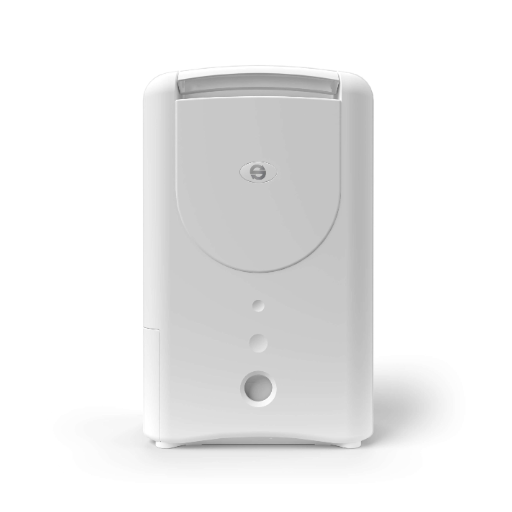
Energy Efficiency
Rotary dehumidifiers are typically designed to optimize energy consumption while giving the highest performance in moisture control. The advanced construction usually involves a rotary-type desiccant wheel functioning therein, thus allowing more or less continuous dehumidification without very complex and energy-intensive refrigeration cycles. This provides a huge saving in energy compared to conventional compressor systems. Since adsorption rather than condensation is the working principle, rotary dehumidifiers manage to hold efficiency for settings that common systems would have lost it, such as cold temperatures and low humidity.
The capacity of rotary dehumidifiers to couple with, say, energy-recovery systems adds to their efficiency. For example, quite a few contemporary machines are equipped with an energy recovery wheel or heat exchanger that lets them capture the waste heat being thrown off during dehumidification so that they can use the energy for pre-conditioning incoming air or some other heaters, which in turn eliminates the need for extra external inputs of power.
While continuing advances in materials and control technologies have given rise to better desiccants and motorized systems, they have made it possible for airflow and moisture extraction rates to be modulated with great precision so that the energy expended corresponds precisely to the requirements of the application. Control systems located in the field that are often integrated with IoT monitoring platforms contribute greatly to energy optimization as operations are adjusted in real time based on changes in the environment. Hence, this level of precision is an enabler for sustainability and cost reduction in operations throughout the system lifecycle.
Consistent Humidity Control
The control of humidity constitutes an essential parameter in working efficiently in a multitude of industries, including manufacturing processes, data centers, and healthcare facilities. Control systems maintain precision in moisture level control within the air, so any temperature variation might otherwise hamper the normal operations of a sensitive piece of equipment, damage the materials, or even hamper collection quality. Impurities in humidity levels outside a certain tight band contribute to inefficiency and increased maintenance costs and might be severe safety hazards in a critical environment. Present-day control systems rely upon advanced sensors and sophisticated feedback loops, which provide a continuous process of humidity level detection and adjustment.
When coupled with Internet of Things (IoT) platforms, the humidity control systems acquire the capability for real-time data collection and predictive analytics. For example, IoT-enabled sensors measure ambient temperature and humidity with utmost accuracy and transfer such data to cloud-based analytic platforms. These platforms, governed by machine learning algorithms, forecast the trend or environmental changes such that prior to any change in the system, the system shall preemptively adjust itself to maintain control. This saves a lot of energy since the environment fast stabilizes and doesn’t undergo another correction being excessive, hence further reducing the carbon footprint of the process.
Studies show that automated humidity control solutions integrated with predictive analytics can improve energy efficiencies by 30% compared to a usual or traditional system. Also, pharmaceutical or semiconductor manufacturing industries where critical environmental conditions are required can attain tighter regulatory compliance with the implementation of such systems. The incorporation of advanced technologies in this manner serves the global sustainability goals directly while also ensuring improved reliability and economy of operations. Further refinements in the consistent humidity control methods and efficiency will be assured with continuous advances in data processing and system connectivity.
Applications in Various Settings
Considered among the varied fields and environment-specific requirements concerning precise environmental regulation are the high humidity control techniques. The key fields where these systems become imperative are as follows:
- Pharmaceutical Manufacturing: Very strict humidity control is required for pharmaceutical production and storage. Excess moisture may cause the drugs to lose their therapeutic nature, while less moisture may cause the drugs to get brittle or other spoilage of the photosensitive drugs. Studies have found that controlling humidity consistently decreases up to 20% production loss, ensuring regulatory compliance and product quality.
- Semiconductor Production: Semiconductor manufacturing needs ultra-clean conditions with temperature and relative humidity levels maintained within close limits. Any deviation from the normal values of relative humidity may have serious consequences, leading to set-up malfunctions or defects arising in the process of microchip production. These advanced systems keep relative humidity within ±1% of set points between specified limits to protect critical manufacturing processes.
- Food Storage and Processing: In food facilities, humidity controls prevent spoilage and contamination, thus increasing shelf life and ensuring safety standards. For instance, moisture-sensitive products, such as powdered milk or spices, should be kept in an environment below 50% relative humidity. Any error in monitoring invites mold, bacteria, and degradation of the product.
- Healthcare Facilities: On the other hand, stable humidity levels are maintained in hospitals and laboratories in sterile conditions to preserve medical equipment and improve patient comfort. Studies have shown that the control of indoor humidity within a range of 40-60% makes the environment suitable for suspending airborne diseases and the advanced medical equipment.
- Data Centers: The high-performance computing infrastructures get damaged by either high humidity, causing condensation, or low humidity, causing electrostatic discharge. Modern humidity control systems maintain a consistent environment, thereby preventing the risk of downtime and enhancing the lifespan of critical equipment. Industry data revealed a 30% reduction in hardware failures at installations where advanced humidity management was practiced.
Each application mentioned above underlines the importance that humidity control carries in maximizing operational efficiency, ensuring safety, and complying with stringent industry standards.
Comparing Rotary Dehumidifiers with Desiccant Dehumidifiers
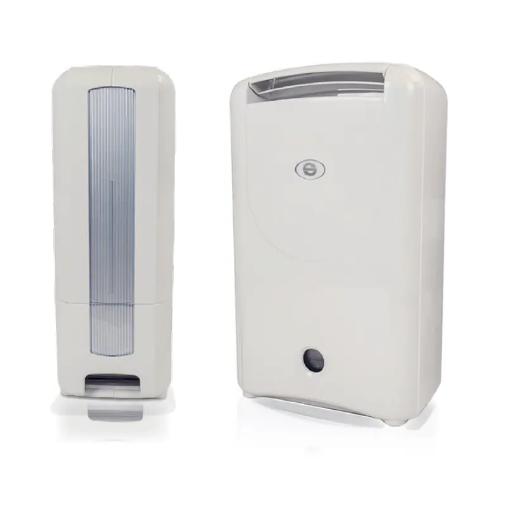
Functionality and Mechanisms
So, while rotary and desiccant dehumidifiers are built to regulate the moisture level of air, their treatments are quite opposite, hence their suitability in different setups. Rotary dehumidifiers operate on the refrigerant cooling principle. Warm, moist air is drawn inside and passed over cold coils, where moisture condenses to form a liquid, which is drained away. These systems are most efficient in warm climates where the removal of moisture is of utmost priority. This also makes them a cheaper option since they consume less power as against other systems, appropriate for home and office spaces.
Desiccant dehumidifiers, however, use hygroscopic materials, such as silica gel or lithium chloride-that adsorb moisture. Air is passed over a desiccant-coated rotor or wheel, wherein the water vapor clings to the material. The desiccant is then regenerated, which means heating it to expel the water it has absorbed, thus enabling the water to be expelled from the system. This system works well under cold conditions where the other types of refrigerant systems have difficulty. Besides keeping the humidity of industrial processes at an absolute minimum, where it is essential for the drugs or the storage of food, desiccant dehumidifiers find their application.
In context, an understanding of the differences truly establishes the suitability of any one system over the other, based primarily on environmental factors, target humidity levels, or energy efficiency requirements. Both technologies work most of the time in moisture conditioning, but only when a thorough assessment is done on the actual operating environment.
Advantages of Rotary Models
- Efficiently Operating at Low Temperature and Humidity: These rotary dehumidifiers work best in slightly cool and dry environments. They are capable of extracting moisture quite efficiently under these conditions and are therefore ideal in industrial application settings, such as in pharmaceutical storage or food processing plants.
- Stable Performance under Environmental Variability: These do not behave the way the other systems do under environmental variations in dehumidification ability. Their reliability affirms their stability in operation; hence, they must be used in critical environments where exact humidity control is required.
- Energy Efficiency: Since these devices have the design advantageous in to of consuming less energy in comparison to other systems, rotary dehumidifiers save energy and operational costs. With advanced alternative systems, energy consumption has been reduced by 20%, which is a great saving in heavy commercial usage.
- Compact and Modular Design: Usually being compact in design, rotary dehumidifiers offer advantages in installation and integration into an existing system. Most models have a modular concept that can be customized or expanded to suit the needs of various industrial operations.
- Extremely Durable and Requires Minimal Maintenance: Due to the strong materials and technology used in finishing the structure, the rotary kind is highly durable and needs almost no maintenance. In various studies, it is shown that these units can serve for a long time continuously, thereby reducing downtime and interference in irregular operation.
Such advantages make rotary dehumidifiers a sound moisture control solution that is highly reliable and efficient, suitable for specialty processes in various industrial and commercial settings.
Disadvantages and Limitations
Rotary dehumidifiers, while highly effective and reliable, do indeed have a scope of drawbacks and associated limitations. Listed below are five points of such drawbacks:
- High Up-front Price: The initial capital outlay for rotary dehumidifiers is much higher than that for other dehumidifier types. This is because of the advanced nature of their working principles and the specialized components required. Industrial-grade equipment may range from $10,000 to $50,000 based on capacity and features. This can deter smaller businesses or any application with modest funds.
- Energy Consumption: Because of the continuous operation cycle in desiccant regeneration, rotary dehumidifiers consume energy in considerably high quantities. According to the literature, for large industrial units, energy consumption spikes beyond 3-5 kW per hour levels, depending on humidity levels and operational needs. This can then lead to increased operational costs down the line, especially in energy-dependent setups.
- Maintenance Complexities: Though rotary dehumidifiers are built to last, the maintenance process can take a complicated nature and consume time. Critical parts of the unit, such as the desiccant wheel and drive motors, require periodic inspection and cleaning, and sometimes replacement. If not maintained well, these units may start to work inefficiently and could even break down.
- Size and Installation Demands: The bulky nature of rotary dehumidifiers demands copious installation spaces. Industrial units require dedicated floor spaces and may even include structural reinforcements for their appropriate mounting. This would be a big downside for tightly packed or cramped locations.
- Poor Operation Under Certain Unusual Conditions: Despite their general good operational performance at various humidity levels, in conditions that are quite cold, rotary dehumidifiers may start to show substandard performance. At temperatures lower than 10°C (50°F), for instance, their performance is generally degraded due to icing hazards and dwindled effectiveness in regenerating desiccant. Other methods of dehumidification might take precedence in such environments.
Such limitations impose more disadvantages, but in several instances, choosing appropriately, planning carefully, and conducting all the required regular maintenance can easily eliminate them.
Choosing the Right Rotary Dehumidifier
Key Factors to Consider
When selecting a rotary dehumidifier, there are certain critical factors to keep in mind to ensure satisfactory performance and system efficiency in that particular environment. The chief considerations include the following:
- Capacity and Airflow Requirements: The capacity of a rotary dehumidifier, determined by liters per day of moisture removal, must suit the moisture control needs of the area concerned. The airflow rate, expressed in cubic feet per minute (CFM), is also of critical concern for ensuring adequate coverage. Overestimating or underestimating these values diminishes system efficiency and longevity.
- Operating Conditions: Consider the temperature and humidity conditions within which the system will be working. While some desiccant-based models work optimally in conditions where low temperature or high humidity prevails, others become inefficient outside their prescribed working range. Thus, subject performance specifications for compliance with these variables.
- Energy Consumption: Energy conservation is paramount; compare kilowatt-hour energy consumption against a given moisture removal rate. Energy Star-certified models, for instance, may translate into long-term savings despite their higher upfront costs.
- Material Durability and Corrosion Resistance: The materials of construction are of special concern in industrial or other highly humid environments. Components should be able to resist corrosion and wear, especially if the system will be exposed to saline air or chemical by-products.
- Control Features and Automation: Advanced units come with programmable control panels, humidity sensors, and automated setpoints that can adjust the operation of the system in real-time. Attempt to consider those that can hook into a Building Management System (BMS) for seamless monitoring and control.
- Maintenance Requirements: Consider how easy it is to maintain the unit, including frequency and accessibility of component replacements like filters and desiccant wheels. Low-maintenance designs translate to less downtime and operational disruption.
- Compliance and Certifications: Compliance with regional safety and environmental regulations should be assured for the dehumidifier. Certifications like the CE mark or an ISO-compliance shall indicate that the equipment has been built to pre-set strict industry standards.
Proper assessment of these factors shall allow consideration of a rotary dehumidifier geared to the specific needs of your application, thereby reducing the risk factors in operation and maximizing effectiveness and efficiency.
Capacity and Size Requirements
The moisture removal rate required for the application must be the center of consideration for capacity and size selection for rotary dehumidifiers. Dehumidifier capacity is measured in units of pints or liters of moisture removed per day, based on environmental conditions and the size of the space. For industrial applications, the greater-capacity units of up to 50 liters a day and as high as several hundred liters a day are generally needed, whereas, for residential or light commercial applications, lesser capacity units would do.
A few other factors that affect sizing decisions include total volume space, ambient humidity, and temperature. For example, higher-capacity units would be required if the area is large or if the humidity remains quite high. By and large, the airflow rate, measured in cubic feet per minute (CFM), should be compatible with the space constraints to allow air circulation to pass through.
Consider Energy Star ratings for energy efficiency to know that the unit maintains performance without excessive energy consumption. A dehumidifier with a properly sized water tank or drain will guarantee operation without interruption and will minimize monitoring. Aligning capacity and size with the rotary dehumidifier according to your operational requirements will ensure a better-performing unit with less energy costs over time, with equipment longevity.
Maintenance and Operational Costs
When considering rotary dehumidifiers, they should be easy to maintain and inexpensive to operate. Some types of regular maintenance cleaning or replacement of air filters, inspecting the desiccant rotor for any wear, etc., must be necessary for the proper working of the unit and good life. Lubricating and checking the electrical parts periodically will also help to avoid an efficiency loss or malfunctioning as time goes by.
The unit operating cost generally considers energy consumption, hours of operation, and environmental factors. In other words, energy-efficient models may use variable speed fans or energy recovery systems that cut down the power consumption during operation. As reported by recent studies of the industry, a rotary dehumidifier with energy-efficient ratings can cut energy costs down by approximately 20 to 25% compared to non-optimized types when operating in a controlled environment. Moreover, a precise calibration of dew point and humidity setpoints may ensure further energy savings.
Predictive maintenance systems and IoT-enabled dehumidifiers can also drastically reduce unplanned downtimes and maintenance costs. These systems collect real-time performance data and generate actionable insights so that operators can intervene on minor problems before they develop into critical issues. Thanks to this alignment of conscientious maintenance with advanced technology, dehumidification processes offer an appealing mix of reliability and cost-effectiveness for any business.
Rotary Dehumidifiers vs. Traditional Rotary Desiccant Wheels
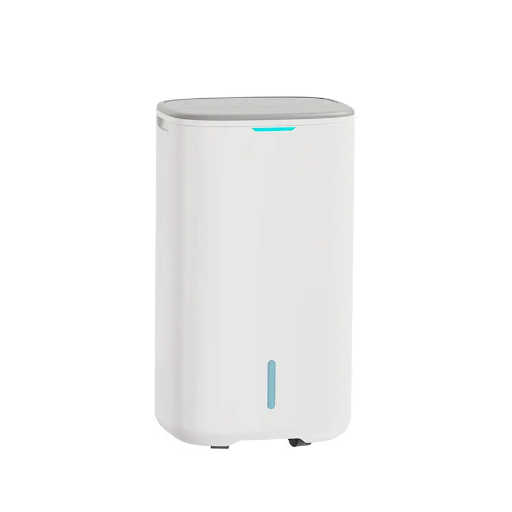
Mechanism Differences
While rotary dehumidifiers and conventional rotary desiccant wheels bear a certain similarity in their means of dehydration, it is important to understand the very essence of their operative distinction. Rotary dehumidifiers operate by a closed-loop system wherein humid air is passed around the rotating desiccant material that manages to catch water vapor. Then, heat is applied in a specified environment for regenerating the desiccant, thus allowing uninterrupted working of the unit without having to undergo considerable downtime. Such a design is more efficient where uninterrupted control of humidity is required by the industry.
Conversely, the traditional rotary desiccant wheels work in a fairly simple manner. In such configurations, the desiccant-coated wheel rotates alternately absorbing moisture from the air and releasing it during the regeneration phase. Despite their relative simplicity, the efficiency of these traditional systems greatly depends on the size, the speed of rotation, and the temperature of the reactivation air, and this could reduce their use in applications where strict humidity controls are required.
In a personal view revolving around this, I find rotary dehumidifiers to meet the needs for real-time controls and energy optimization features much better for today’s industrial scale. It all makes a difference when one is concerned with operational efficiency and scale-up. The selection of one over the other largely depends on the different application needs, budgets, and probably the level of technological sophistication required.
Performance Comparison
Key elements that define the comparative study of rotary and desiccant dehumidifiers are moisture throughput efficiency, energy consumption, and operational adaptability. Rotary dehumidifiers essentially depend on a wheel that rotates continuously for moisture absorption and desorption, supported by a highly efficient heat-exchanging mechanism. This consistent performance makes it favorable in an environment of medium to high humidity, and in cases where industrial importance is attached to stability and throughput.
Conversely, desiccant dehumidifiers absorb moisture chemically via specially treated materials, such as silica gel. This mechanism is mostly efficient in very low-temperature sorts of atmospheres or those requiring very low humidity. Conversely, desiccant systems are usually more energy-consuming due to using external heating elements to regenerate the desiccant.
Much development in the field has since improved the energy efficiency of both technologies. For instance, rotary dehumidifiers are increasingly equipped with variable-speed drives and sophisticated sensors to enable dynamic responses to changes in environmental conditions. Meanwhile, new-generation desiccant systems include thermal recovery loops to cut down on energy wastage during regenerative cycles.
References
-
Comparative analysis of a new desiccant dehumidifier
This study explores the potential of rotary desiccant dehumidifiers as air conditioning systems in high-humidity regions. -
Rotary Solid Desiccant Dehumidifiers Analysis of Models
This paper analyzes the development and design models of rotary desiccant dehumidifiers for air conditioning systems. -
Performance prediction of rotary solid desiccant dehumidifiers
The article uses an artificial neural network (ANN) model to predict the performance of rotary desiccant dehumidifiers under different air inlet conditions. -
Experimental Results on Advanced Rotary Dehumidifiers
This research provides an engineering database and design tools for evaluating rotary dehumidifiers in desiccant cooling applications. -
Optimization of a rotary desiccant wheel for enthalpy transfer
The paper develops and validates a numerical model for heat and moisture transfer in rotary desiccant wheels.
Frequently Asked Questions (FAQ)
Q: What is a rotary dehumidifier?
A: A rotary dehumidifier is a type of dehumidification system that uses a rotating desiccant wheel to absorb moisture from the air. This technology is designed to provide efficient air dehumidification while maintaining low energy consumption.
Q: How does a rotary dehumidifier work?
A: A rotary dehumidifier operates by utilizing a rotating desiccant wheel that absorbs moisture from the air. As the wheel rotates, the absorbed moisture is then released through a regeneration process, often involving heat generated by the adsorption effect, leading to dry air output.
Q: What are the benefits of using rotary desiccant dehumidifiers for air conditioning?
A: Rotary desiccant dehumidifiers enhance air conditioning systems by improving dehumidification efficiency, allowing for better control of air humidity levels. They also contribute to energy saving by reducing the workload on traditional air conditioning units.
Q: Can rotary dehumidifiers be used in industrial settings?
A: Yes, rotary dehumidifiers are widely used in industrial applications due to their effective dehumidification capacity and ability to handle large volumes of air. They are particularly useful in environments where maintaining low humidity levels is crucial.
Q: What is the difference between traditional rotary dehumidifiers and desiccant dehumidifiers for air conditioning?
A: Traditional rotary dehumidifiers typically rely on condensation methods, whereas desiccant dehumidifiers for air conditioning use desiccant materials to absorb moisture. The latter can operate efficiently at lower temperatures and humidity levels.
Q: How does the configuration of the desiccant dehumidifier affect its performance?
A: The configuration of the desiccant dehumidifier affects its performance by influencing the contact time between the air and the desiccant material. An innovative design can improve the dehumidification coefficient of performance, ensuring better moisture removal.
Q: What are the energy savings associated with rotary dehumidifiers?
A: Rotary dehumidifiers can lead to substantial energy savings by reducing the need for excessive heating and cooling in air conditioning systems. By maintaining optimal humidity levels, they enhance the coefficient of performance of the overall system.
Q: How do rotary dehumidifiers manage outside air intake?
A: Rotary dehumidifiers can efficiently manage outside air intake by pre-treating the incoming air to lower its humidity before it enters the air conditioning system. This process helps to maintain a controlled indoor environment.
Q: What role does air temperature play in the effectiveness of rotary dehumidifiers?
A: Air temperature significantly affects the performance of rotary dehumidifiers. Warmer air can carry more moisture; thus, maintaining appropriate air temperatures can enhance the drying wheel’s efficiency and improve overall dehumidification capacity.
Q: What types of desiccants are used in rotary dehumidifiers?
A: Various types of desiccants are used in rotary dehumidifiers, including silica gel and zeolites, which are known for their high moisture-absorbing capabilities. These materials are essential for achieving efficient air dehumidification in various applications.

